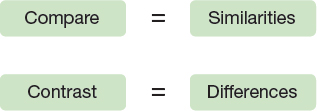11
Comparison and Contrast
Writing That Shows Similarities and Differences
Understand What Comparison and Contrast Are
Comparison is writing that shows the similarities among subjects — people, ideas, situations, or items; contrast shows the differences. In conversation, people often use the word compare to mean either compare or contrast, but as you work through this chapter, the terms will be separated.

Four Basics of Good Comparison and Contrast
It uses subjects that have enough in common to be compared/contrasted in a useful way.
It serves a purpose—
to help readers make a decision, to help them understand the subjects, or to show your understanding of the subjects. It presents several important, parallel points of comparison/contrast.
It arranges points in a logical order.
In the following paragraph, written for a biology course, the numbers and colors correspond to the Four Basics of Good Comparison and Contrast.
4 Points arranged in a logical order
1 Although frogs and toads are closely related, 2 they differ in appearance, in habitat, and in behavior. 3 The first major difference is in the creatures’ physical characteristics. Whereas most frogs have smooth, slimy skin that helps them move through water, toads tend to have rough, bumpy skin suited to drier surroundings. Also, whereas frogs have long, muscular hind legs that help them leap away from predators or toward food, most toads have shorter legs and, therefore, less ability to move quickly. Another physical characteristic of frogs and toads is their bulging eyes, which help them see in different directions. This ability is important, because neither creature can turn its head to look for food or spot a predator. However, frogs’ eyes may protrude more than toads’. The second major difference between frogs and toads is their choice of habitat. Frogs tend to live in or near ponds, lakes, or other sources of water. In contrast, toads live mostly in drier areas, such as gardens, forests, and fields. But, like frogs, they lay their eggs in water. The third major difference between frogs and toads concerns their behavior. Whereas frogs may be active during the day or at night, most toads keep a low profile until nighttime. Some biologists believe that it is nature’s way of making up for toads’ inability to escape from danger as quickly as frogs can. At night, toads are less likely to be spotted by predators. Finally, although both frogs and toads tend to live by themselves, toads, unlike frogs, may form groups while they are hibernating. Both creatures can teach us a lot about how animals adapt to their environments, and studying them is a lot of fun.
Many situations require you to understand similarities and differences.
| COLLEGE | In a pharmacy course, you compare and contrast the side effects of two drugs prescribed for the same illness. |
| WORK | You are asked to contrast this year’s sales with last year’s. |
| EVERYDAY LIFE | At the supermarket, you contrast brands of the same food to decide which to buy. |
In college, writing assignments may include the words compare and contrast, but they might also use phrases such as discuss similarities and differences, how is X like (or unlike) Y?, or what do X and Y have in common? Also, assignments may use only the word compare.